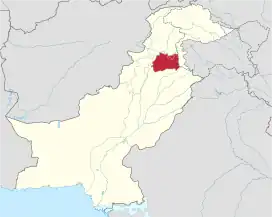Ghakhar Kingdom | |
|---|---|
| 11th century-1818 | |
 Pharwala Fort built by Sultan Kaigohar Gakhar in 11th Century.
| |
 Largest Extent of Ghakhar rule | |
| Status | Tribal Chieftainship |
| Capital | Salt Range |
| Common languages | |
| Ethnic groups | Punjabis |
| Religion | Islam |
| Area | |
• Total | 12,000 sq mi (31,000 km2) |
| Today part of | Pakistan, and parts of Azad Kashmir |
Gakhar Sultanate was a chieftaincy that existed in the Pothohar Plateau and Jech Doab between early 11th and 19th centuries.
History
Gakhars grew powerful under their Sultan, Muqarrab Khan (r.1738–1769), who participated in the battle of Karnal (1739) alongside Nader Shah against Mughals and received the title of Nawab.[1] They controlled major regions of Potohar between Jhelum and Indus, including Rawalpindi, Pharwala, Gujar Khan, Kahuta, Fatehjang and Rohtas.[2] He later also conquered cities of Gujrat and Jhelum in 1740[1] and issued his own coins, in which he declared himself to be ruler of tract between Attock and Chenab.[1] He defeated the Yusafzai Pashtuns and Jang Kuli Khan of Khattak and overran as far north as Bhimber.[1] However, the Bhangi Misl under Sardar Milka Singh forced him to give up control of Gujarat in 1765 and he returned to Jehlum.[1] In 1769 he was treacherously captured and put to death by a rival chief, Himmat Khan of Bugial clan. Ultimately Sikhs conquered Rawalpindi too in 1767 and Gakhars were left with only Phurwala and Jhelum under their control.[1] Muqarrab's son succeeded to his dominions, until Jhelum (1810) and Pharwala (1818) fell to the Ranjit Singh's invasions, and their rule ended.[1][3]
References
- 1 2 3 4 5 6 7 Gazetteer of the Rawalpindi district. "Civil and Military Gazette" Press. 1895.
- ↑ Punjab District Gazetteers: Rawalpindi District (v. 28-A). Haideri Press. 1909.
- ↑ Gandhi, Surjit Singh (2007). History of Sikh Gurus Retold: 1469-1606 C.E. Atlantic Publishers & Dist. ISBN 978-81-269-0857-8.
_with_cities.png.webp)